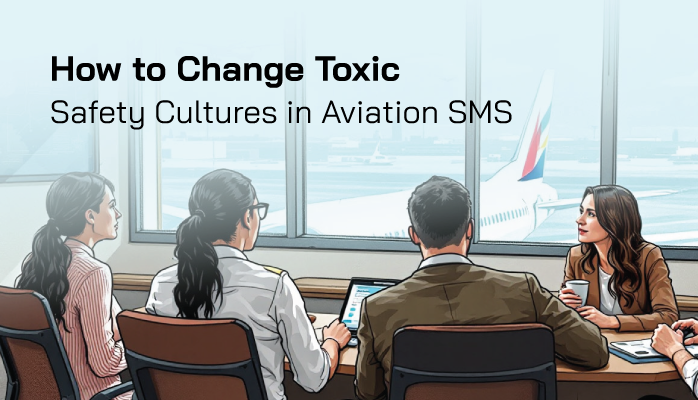What Is Safety Culture in Aviation SMS

Aviation safety cultures are the attitudes, behaviors, and actions that drive safety performance in your SMS.
Safety culture includes how management supports safety, and what front-line employees do when no one is watching.
There are different aspects of safety culture that, together, represent the overall safety culture of an organization:
- Commitment of program to safety;
- Safety behavior in SMS;
- Safety communication and information access;
- Justness;
- Awareness and hazards/risks; and
- Adaptability to changes and events.
When attempting to change toxic safety cultures in aviation SMS, the two primary aspects of safety culture that organizations should try and influence are:
- Communication; and
- Awareness.
With good communication and awareness, other aspects of safety culture tend to follow with a type of domino effect. In other words, awareness easily leads to behavior, and justness leads to commitment.
1 – Get Upper Management Support
When it comes to changing toxic safety cultures in aviation SMS, upper management needs to support the SMS. If upper management is not totally supportive, then the safety culture has little hope for change.
Even with an excellent safety leader/champion, the top-down nature of safety culture means that poor safety culture in upper management will always undermine the efforts of a safety champion. Good ways to get upper management support are demonstrating:
- Financial benefit of supporting the SMS;
- Ability to enhance airline / airport reputation;
- Separating airline / airport from the competition;
- How SMS is socially responsible;
- How SMS can be used as a marketing/sales tool; and
- Most importantly, how upper management can take responsibility for the improvement and success of aviation SMS.
Furthermore, in situations of toxic safety cultures, you can also point out to safety executives how much the poor safety culture can negatively influence company reputation, compliance, etc.
2 – Accountable Executive Support of SMS
In addition to upper management support, your accountable executive needs to spearhead the safety program. Their role is to set the tone and concern for the SMS that will be adopted by the company.
Accountable managers should:
- Gather appropriate budget for safety program;
- Always attend safety meetings;
- Regularly meet with safety manager to debrief on important safety topics;
- Cosponsor safety activities, such as newsletters, surveys, and initiatives;
- Write and sign an accountable executive commitment to safety; and
- Ensure that employees and managers see the accountable executive doing tasks in a safe capacity.
When employees see top, accountable managers actively involved in the safety program, it sends a powerful message to the organization about the importance of the safety program.
3 – Focus on Building Hazard Reporting Culture

With upper management support, building a hazard reporting culture is the natural place to start when attempting to change toxic safety cultures in aviation SMS. Why?
- There are many resources for building hazard reporting culture;
- It is probably the easiest part of safety culture that you can influence;
- Results can be quick;
- Building a reporting culture is straightforward;
- Results are tangible; and
- Building a hazard reporting culture can make dramatic changes to the safety culture.
The goals of hazard reporting culture are ensuring that employees:
- Recognize threats, hazards, etc;
- Feel comfortable reporting safety issues;
- Have a safety mindset;
- Have safety awareness; and
- Can report issues in any given situation.
The best ways to build hazard reporting culture are:
- Train employees on hazard identification;
- Make sure hazard reporting process is very easy;
- Make sure there are multiple ways to report issues, such as via:
- Email, such as by emailing specific company email addresses;
- Desktop computer, such as a laptop;
- Mobile devices, such as a phone;
- Offline, when not connected to the internet;
- Aviation SMS software; and
- Public places, such as company website, etc.
- Employees can monitor what happens to their hazard reports after they submit; and
- Have quality hazard reporting forms with enough fields to capture essential information but not so many fields that hazard reporting is inconvenient.
Related Aviation Hazard Reporting Culture Articles
- Indicators of Good Hazard Reporting Culture
- Best Practices for Hazard Reporting in Aviation SMS - With Examples
- What Is Offline Hazard Reporting in Aviation SMS
4 – Focus on Safety Communication
Safety communication is critical for building a safety culture. The most important parts of safety communication are how your organization handles:
- Transparency, which is access to safety information;
- Just culture, which means employees won’t be penalized for communicating safety issues; and
- Means of communication.
In short, communication is the foundation of safety culture. It affects:
- How aware of safety information employees are;
- How willing employees are to share safety information (via hazard reporting);
- How receptive employees are to management’s decisions.
Improving safety communication involves:
- Constant communication between management and front-line employees;
- Strong non-punitive reporting actions; and
- Strong lines of safety communication, such as via an SMS org chart, anonymous and confidential hazard reporting, etc.
5 – Invest in Physical Safety Promotion
Though things like posters and other forms of physical safety promotion will probably become “background noise” for employees, it’s hard to underestimate how important imbuing your environment with safety promotion can be.
Even though employees might not be actively reading the safety promotion posters and other items, having these items everywhere is a way of conditioning employees to:
- Be mindful of safety;
- Behave safely; and
- Accept the SMS.
How is the quality of your safety culture? Take this free quiz to evaluate your organization's safety culture:
Last updated October 2025.






